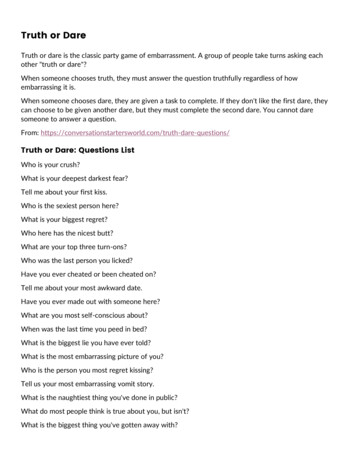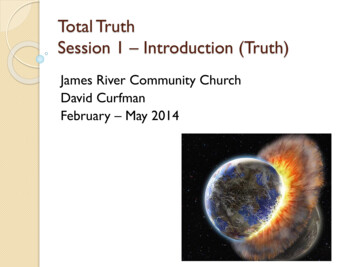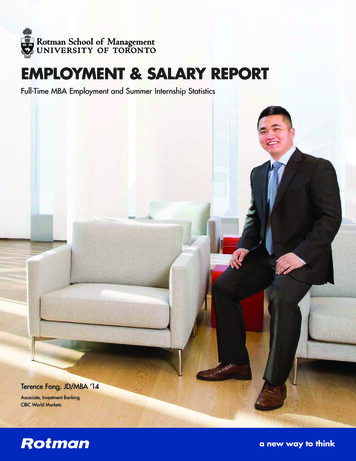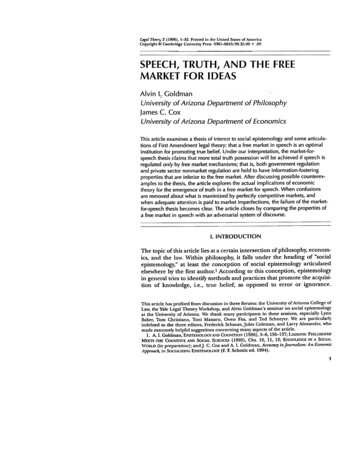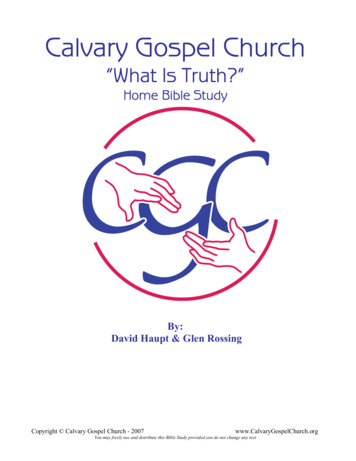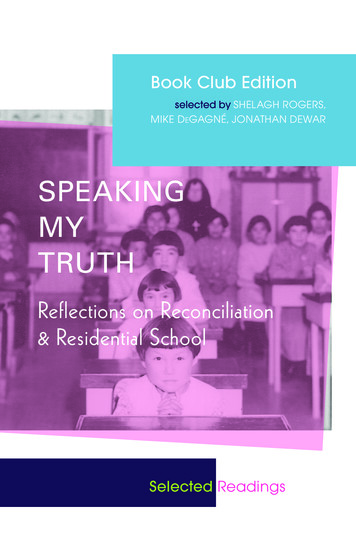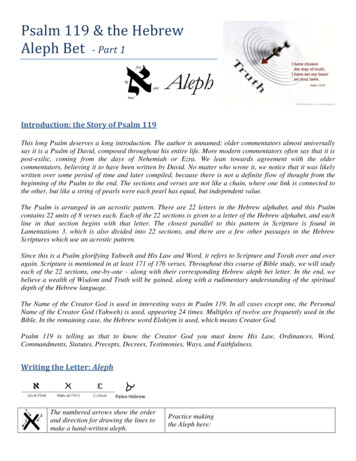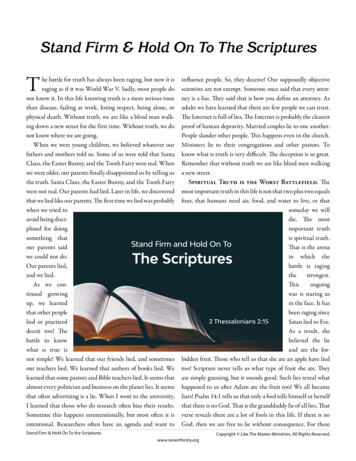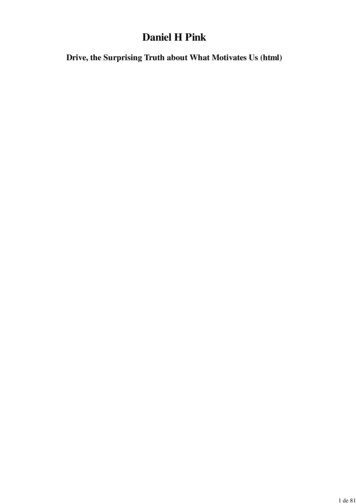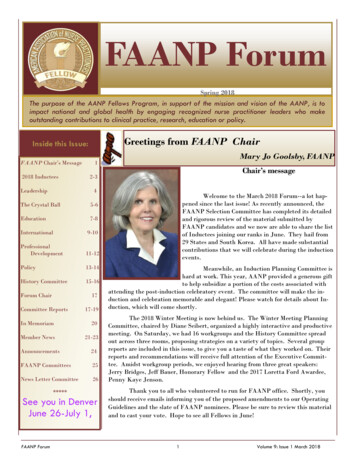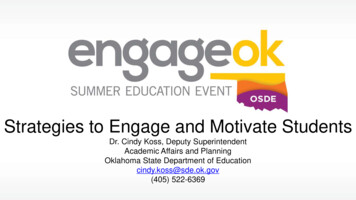
Transcription
Strategies to Engage and Motivate StudentsDr. Cindy Koss, Deputy SuperintendentAcademic Affairs and PlanningOklahoma State Department of Educationcindy.koss@sde.ok.gov(405) 522-6369
Learning GoalsTo understand how to use research-basedlearning activities to motivate and engagestudents.To identify learning activities to use immediatelyto engage and motivate students in yourclassroom.
Research on Motivation and EngagementDaniel Pink, author of DRIVE: The SurprisingTruth About What Motivates Us, explainsresearch indicating that we are motivated by: Purpose Mastery Autonomyhttp://www.danpink.com/
ANTICIPATION GUIDE1. All teachers in secondary schools realize the need to motivate and engage students.2. When students are highly social, sharing their reading and writing frequently they are likelyto be active, interested learners.3. Students can easily memorize lyrics to songs, become skilled at video games, and learnnew athletic maneuvers because those things are easier and less abstract than schoolwork.4. Students who are engaged in learning, do not talk to their friends during class, do notdraw pictures on their notebooks, and do not use their cell phones.5. Motivating high school students is incredibly challenging.6. Preparing lessons that are really engaging takes too much time.7. High levels of active engagement during lessons are associated with higher levels ofachievement and motivation.
1. ANTICIPATION GUIDEValidates students’ priorknowledge.Encourages students to readfor detail.All opinions must besupported by evidence.Students will debate variousperspectives in order to cometo consensus.Dr. Mark Forget MAX Teaching with Reading and Writinghttp://www.maxteaching.com
BRAINSTORMList all of the activities in which you have seenteenagers become engaged.
Research on Motivation and EngagementBased on brain research conducted by the video gaming industry.Responds to theOut-of-theOrdinaryResponds toVisual ImagesResponds toEmotions (e.g.humor, curiosity,fun)Responds toSustainedPatternsResponds toConversationResponds toChallenge
STUDENT ENGAGEMENTSupportive Environment (Responds to Emotions)Meaningful Content (Responds to Sustained Patterns)Choice (Responds to Challenges)Lively Environment (Responds to Out of the Ordinary)Collaborative Atmosphere (Responds to Conversation)
Research on Motivation and EngagementWhat causes a student to want to know something? If it is something relevant to their lives If it is information needed to solve a problem If they will get to “show off” their knowledge If they have been engaged long enough to see thevalue in sticking with it longer
STUDENT LEARNINGWHY DO WE NEED TO MOTIVATEAND ENGAGE STUDENTS INLEARNING?
Why do we need to motivate andengage students in learning? Make our students accountable Provide ways for students retain more with greater depth asthey interact with the content in meaningful ways Allow students the opportunity to explore content andlanguage on their own Provide opportunities for student to student interaction tohelp students develop language skills Promote an environment of academic risk taking Teach students structure, responsibility, and deadlines
2. Student Response FormatsResponse Cards, Clickers, WhiteboardsClickers ProvideGame-Like AtmosphereQuick PollImmediate FeedbackOpportunity to DiscussMisconceptions or AcceleratePace of InstructionAnonymity to Classmates –Identified to the TeacherPurposeMasteryChoiceIf response cards were used instead of handraising for just 30 minutes per day, eachstudent would make more than 3,700additional academic responses during theschool year.
3. CORNELL NOTESPurposeMasteryChoice
4. BUILDING ACADEMIC VOCABULARYBuilding BackgroundKnowledge is essential beforeembarking upon newcontent.Must: Follow the six-step process. Have a building-wide ordistrict-wide initiative. Identify 30 words percontent area per year.PurposeMastery1. Description or Explanation2. Student restates in his/her own words.3. Student construct s picture, symbol or graphic.4. Engage students in revisiting their definition.5. Students discuss terms with one another to gain in depth understanding .6. Involve students in games to better understand words/concepts.
5. FRAYER NGNon-Examples
6. FIND SOMEONE WHO
7. JIGSAWStudents become experts for one aspect of anarea of study or one piece of informationcritical to understanding a concept.Students sign up to become experts for oneor more items from a teacher-prepared list.PurposeProvide 4x6 index cards – I/We’re Experts on , as a way tocollect information, make connections, take notes on front andcreate an illustration on back to help students rememberinformation.
8. ANNOTATE (Record of Thinking) I Agree & Know This? Raises a Question Connection* Interesting! ImportantX DisagreePurposeMasteryChoiceEngaging work, work that stimulated their curiosity, permittedthem to express their creativity, and fostered positiverelationships with others. It was also work at which they weregood.How, then, would we define engagement? Perhaps the bestdefinition comes from the work of Phil Schlecty (1994), who saysstudents who are engaged exhibit three characteristics: (1) theyare attracted to their work, (2) they persist in their work despitechallenges and obstacles, and (3) they take visible delight inaccomplishing their work.September 1995 Volume 53 Number 1Strengthening Student Engagement: What Do Students Want (and what really motivates them)?Richard Strong, Harvey F. Silver and Amy Robinson
PurposeMastery
10. CELEBRATING ACCOMPLISHMENTSOur students talksmart!Our students produceimportant work!MotivationTake pictures of your studentsengaged in academic work, qualityconversations or quality workshowing their insights. Paste theirpictures in the boxes at varioustimes throughout the year toacknowledge or celebrate theiracademic success.Our students love tolearn!Our students believe ineach other!
Purpose11. GRAPHIC ORGANIZERSVisually representconcepts, ideas, andbeliefsSometimes referred to asThinking Maps or MindMapsEasily created using“SmartArt” in MicrosoftproductsCan be as simple as aT-ChartMastery
12. VOTE WITH YOUR FEETEmotional interactionbetween students on topicsof interestCan be used as a pre-unit,mid-unit, or end-of-unitlearning activity.PurposeMasteryChoice
VOTE WITH YOUR FEETProviding engaging activities motivates studentsto learn.ALL Students can learn if they are engaged in anactive learning process.
13. COLLABORATIVE POSTERPurposeMasteryChoice
14.PurposeMasteryChoice
15. CHOICE BOARDS – DIFFERENTIATIONPurposeMasteryChoice
Purpose16. CUBINGCubing is athinking and/or awriting activitythat permitsstudents to look ata subject from sixdifferentperspectives.MasteryChoice
17. THREE – LEVEL STUDY GUIDEGuides students into higher levelsPurposeof comprehensionLevel 1: LiteralName, Describe, List, Match, Select,State, ChooseLevel 2: InterpretiveSummarize, Classify, Compare,Find Patterns, Predict, Question,OrganizeLevel 3: ApplicationEvaluate, Hypothesize, Solve,ApplyMastery
18. FOCUSED FREE WRITESAs you see these visualimages, shout out the firstword that comes to yourmind – and write it down.Visual images engage theimaginationUse Focused Free Writes tosummarize informationpresented during class as an“exit ticket.”KEY: Everyone writes untiltime is called. It’s OK torepeat a thought until a newone comes.PurposeMasteryChoice
19. ANALOGYEENGAGING STUDENTS IS LIKE NIKE – Because sometimes you have toJUSTDO IT!
Engaging Students is Like . . .BEING THE COWARDLY LION – Becauseyou need courage and a gentle touch
20. EXIT TICKETEXIT TICKET 3-2-13 Strategies you plan to use2 Aha’s about engaging and motivating students in learning1 Comment about today’s ------------------------------Four possible uses for Exit Tickets (Marzano)Rate student current understanding of new learning.Analyze and reflect on student efforts around the learning.Provide feedback to teachers on an instructional strategy.Provide feedback about the materials and teaching.
PURPOSEStudent EngagementMASTERYAUTONOMYwww.ted.com/talks/dan pink on motivation“The surprising truth about what motivates us.” DanielPink (2009)
THANK YOU!Dr. Cindy KossDeputy Superintendent for Academic Affairs & Planningcindy.koss@sde.ok.gov405-522-6369
Daniel Pink, author of . DRIVE: The Surprising Truth About What Motivates Us, explains research indicating that we are motivated by: . dan_pink _on_ motivation . THANK YOU! Dr. Cindy Koss . Deputy Superintendent for Academic Affairs & Planning . cindy.koss@sde.ok.gov . 405-522-6369 . Title: Slide 1
